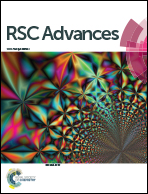Comment on “Quantum interference effects in biphenyl dithiol for gas detection” by J. Prasongkit and A. R. Rocha, RSC Adv., 2016, 64, 59299–59304
Abstract
The paper [Prasongkit et al., RSC Adv., 2016, 64, 59299] by Prasongkit and Rocha calculates the binding energy of gas molecules attached to 1-8-biphenyl-dithiol (BPDT) molecules. We find from our calculations, that the binding energies calculated for the NO2 molecules are too low, most likely due to lacking optimization of the site at which the gas molecule binds to the BPDT. Though not shown explicitly here, the same statement might apply to the other gas molecules used in this paper.


 Please wait while we load your content...
Please wait while we load your content...